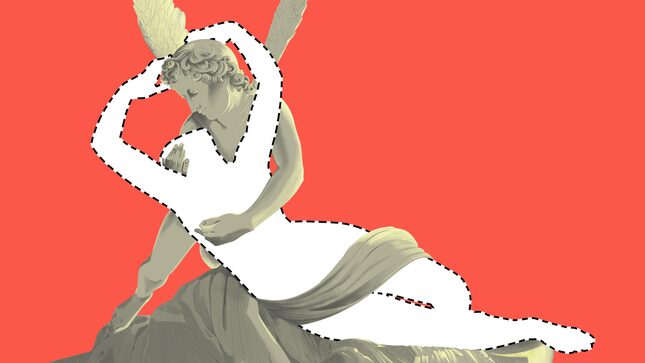I Tried to Learn How to Fuck Like a Goddess
At first glance, the book seems like a perfect vacation or fire-escape read, depending on your local level of quarantine.
In Depth
Illustration: Chelsea Beck
“What if your deepest fears and wounds were the key to living a turned on, passionate life, sharing your gifts with the world, and having mind-blowing orgasms along the way?” reads the back of Alexandra Roxo’s debut book, Fuck Like a Goddess. It felt like a fair question to ask myself at the time, if not also a frightening one. Could I do the difficult, soul-wrenching work of healing my inner demons—if the payoff were mind-blowing orgasms? Sure, why not?
Roxo is a writer, actress, and the self-styled spiritual guide who was behind the Vice documentary Life as a Truck Stop Stripper. But she is best known for her work as a spiritual healer, creating virtual courses on sexual healing, which is the ultimate aim of her book. Roxo argues that all people, but mainly women, have been conditioned to make themselves smaller and to deny themselves sexual liberation because of social and religious constructs. Roxo’s theory is that all it takes to reclaim sexuality is to confront any and all sexual baggage, put it in a neat box, and stash that box somewhere where you can’t reach it ever again, or, as she phrases it, “putting your feelings in a container.” The book is part self-help, part religious undertaking; Fuck Like a Goddess is published by Sounds True, a company with a mission of “disseminating spiritual wisdom.”
At first glance, the book seems like a perfect vacation or fire-escape read, depending on your local level of quarantine. The cover commands: “Heal yourself. Reclaim your voice. Stand in your power.” That seemed like a lot of work, but I had nothing but time, and I figured it would be worthwhile if, in the end, I was better at fucking than when I started. Unfortunately, I quickly discovered that “fucking like a goddess” has little to do with actually fucking. Instead, “fucking” is just Roxo’s euphemism for living a better, more spiritually balanced life that is focused on the energy of the divine feminine, which will allegedly lead to better sex.
Roxo explains this theory in the first chapter:
Whoever taught us that making love or fucking was solely about physical intercorse missed the point. To me, it’s to come into a divine union with. A divine communion with. Whether you are physically or metaphorically fucking, it can mean taking in the energy of creating so deeply that you feel you are making love to your life and that divine creating energy is moving through you. That you are becoming one with the source of all that it is.
In non-spiritual terms, Roxo wants to guide people to aggressive enthusiasm about their lives, to help them feel like they are in control both inside and outside the bedroom. The book provides the reader exercises to obtain this oneness and personal freedom through spiritual and sexual healing, a broad term used by Roxo to describe journaling and meditation. Despite the title, orgasms and physical fucking are not the main goals of the book; instead, the objective is to get more women in tune with the “divine feminine.” We were already off to a rocky start.
The first step in Roxo’s transformation is an internal journey; she asked me to revisit all of my ideas about sex, sexuality, and my own body and to investigate where those ideas came from, assessing if they originated from my upbringing, my religion, or pop culture references. This ritual was actually quite helpful; I don’t think I’ve ever really taken a moment to interrogate my particular feelings about my body, which, for a multitude of reasons, are largely negative. Roxo doesn’t ask in this particular portion of the book that the reader dismantle those ideas all at once but simply wanted me to acknowledge their presence and their roots.
One of the “rituals” Roxo suggests is journaling a “sexual inventory,” which involves sitting in your “container,” her terms for a safe space for healing work, and writing down my entire sexual history. All my partners, all of my experiences with those partners, and any lingering feelings about them, like that skin-crawling sensation I still get thinking about a guy I hooked up with in college who kissed in the exact same way he performed cunnilingus: all pointed tongue flicks and no skill. Roxo refers to this as decluttering my sexual closet. As in the previous ritual, the point was not to change my ideas about these people or events but to simply bring my thoughts to the forefront and store them in a single “container.”
If there is one thing that Roxo’s book emphasizes, it is the power of compartmentalizing. Roxo repeatedly stressed the importance of leaving feelings and thoughts related to this healing practice in the “container.” She advised that if any thoughts related to the ritual arise outside of the container to gently remind myself, “We are leaving all that in the ritual space.” I too love compartmentalizing. But if the end game is self-acceptance and divine love, then shouldn’t that permeate my entire life, even when it’s hard?
-

-

-

-

-

-

-

-

-

-

-

-

-

-

-

-

-

-

-

-

-

-

-

-

-

-

-

-

-

-

-

-

-

-

-

-

-

-

-

-








































